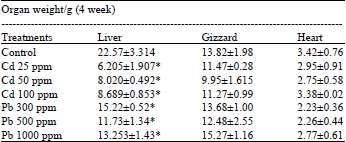Research Article
Toxicity of Cadmium and Lead in Gallus gallus domesticus Assessment of Body Weight and Metal Content in Tissues after Metal Dietary Supplements
School of Environmental and Natural Resource Sciences, Faculty of Sciences and Technology, Universiti Kebangsaan Malaysia, 43600, Bangi, Selangor, Malaysia
M. Shuhaimi-Othman
School of Environmental and Natural Resource Sciences, Faculty of Sciences and Technology, Universiti Kebangsaan Malaysia, 43600, Bangi, Selangor, Malaysia













